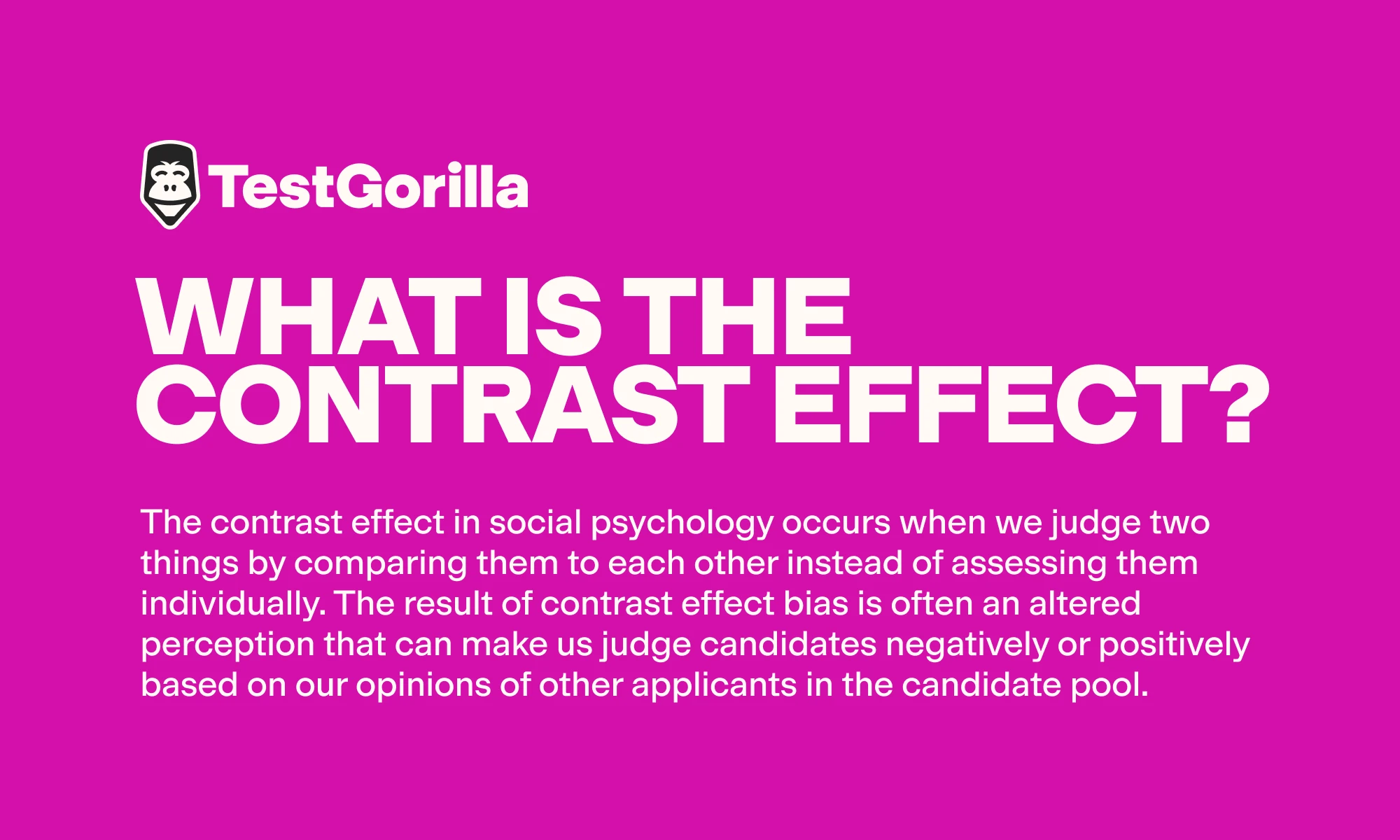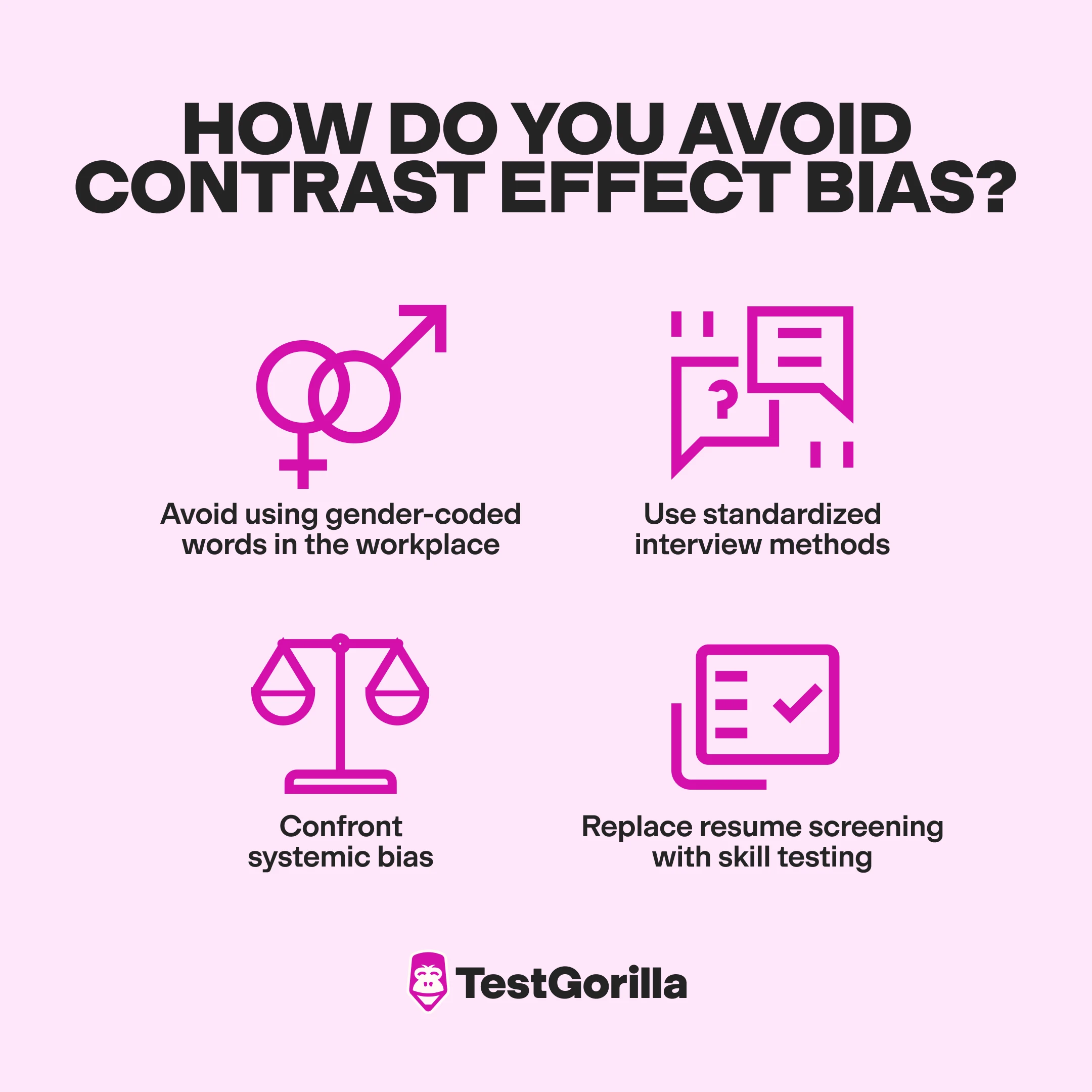The contrast effect bias: What it is and how to avoid it while recruiting
Eliminate the contrast effect from your hiring process with talent assessments.
HR professionals often unknowingly fall into the trap of contrast bias, the tendency to compare candidates against one another instead of evaluating each individual based on a set standard.
If you hire an applicant by unconsciously comparing them to a recently interviewed candidate without considering all of their skills, you can say goodbye to diverse teams, productivity, and company morale.
But is there another way?
Let’s explore contrast effect bias and how to avoid it when hiring or training employees by using skills tests.
Table of contents
What is the contrast effect?
The contrast effect in social psychology occurs when we judge two things by comparing them to each other instead of assessing them individually. The result of contrast effect bias is often an altered perception that can make us judge candidates negatively or positively based on our opinions of other applicants in the candidate pool.
So, what is contrast effect bias in the context of the workforce? Contrast bias can lead to a homogeneous workforce that lacks diversity, which is common in the tech industry when 51% of leaders struggle to recruit diverse tech talent.
Companies that rank high in racial and ethnic diversity are 35% more likely to outperform the industry’s median financial returns.
Contrast bias in recruitment leads to inconsistent hiring standards, high employee turnover rates, and poor team morale.
Positive contrast effect vs. negative contrast effect
Types of contrast effect include positive and negative contrast effects. Despite their names, positive and negative contrast effects distort candidate evaluation and lead to undesirable hiring outcomes.
There’s nothing good about the positive contrast effect. It occurs when a candidate appears more qualified after being compared with those less skilled or impressive.
A classic positive contrast effect example in the workplace occurs when an unqualified applicant seems great because the previous interviewees had fewer qualifications.
Negative contrast bias occurs when a candidate appears less suitable after being compared with more impressive applicants.
For example, a candidate who performs poorly in an interview due to stress can seem less qualified than a confident, attractive person, even if the first person has better skills. That’s why it’s important to test for skills and get the most comprehensive assessment of each applicant.
Other names for contrast effect include:
Assimilation effect
Successive contrast
What is contrast bias in recruitment?
Contrast bias in recruitment is the unconscious bias that occurs when evaluating candidates by comparing them to others instead of objectively assessing skills. It’s common when interviewing multiple candidates in succession or relying on previous assessments.
When we let comparisons influence our judgment instead of focusing on a candidate’s skills, we fall into the trap of contrast error.
The contrast effect bias can affect every stage of the recruitment process, from resume screening to interviewing candidates.
Understanding the contrast effect in psychology helps recruiters recognize how comparing candidates to one another can lead to biased hiring decisions.
Contrast effect bias examples
Now that you understand the contrast effect definition, let’s go over some contrast effect bias examples:
Hiring stage | Contrast effect example |
Technical evaluations | A candidate with basic skills appears more competent than an applicant who performs poorly due to a lack of familiarity with the software. |
Reference checks | If previous candidates received glowing recommendations from their references, you could hold other candidates to a high standard. As a result, you discount otherwise positive but less enthusiastic references for the applicants you interview afterward. |
Interview process | A charismatic candidate can impress you, causing you to scrutinize later interviewees more harshly for lacking similar personality traits, even if those traits are unrelated to job performance. Remember the example of the expensive car parked next to the functional van. |
Portfolio review | A creative director can see an impressive portfolio and subconsciously dismiss the next applicant’s strong but less visually striking portfolio due to the immediate comparison. |
Salary negotiation | When a highly experienced salesperson negotiates a high salary early on, you can perceive subsequent candidates’ reasonable salary requests as less justified due to a slightly different skill set. |
How do you avoid contrast effect bias?
Contrast bias is an intrinsic part of all of us. Our minds make snap judgments of people when we first meet them.
However, in recruitment and the workplace, a few approaches help minimize it.
Here’s a list of four methods to consider:
1. Avoid using gender-coded words in the workplace
In many tech environments and startups, management commonly refers to male employees as “competitive leaders” or “programming ninjas” and female employees as “supportive team members” or “interpersonal and understanding.”
These phrases reinforce gender stereotypes and influence your judgment of those employees through contrast bias.
The best way to reduce contrast bias in the workplace is to avoid using gender-coded words. This approach helps you avoid contrasting male and female employees and offers them opportunities based on their experience or skills instead of stereotypes.
Here are some other terms you should avoid in the workplace to reduce contrast effects:
“Rational decision-maker” vs. “Empathetic communicator”
“Results-driven” vs. “Relationship-focused”
“Confident negotiator” vs. “Good listener”
“Dominant personality” vs. “Caring team player”
Keep in mind that using some of these terms is okay as long as they’re applied based on individual strengths rather than being influenced by gender stereotypes.
For example, a female employee can be considered “results-driven” if she consistently meets and exceeds her targets.
2. Use standardized interview methods
Certain interview styles can introduce the contrast effect bias into your recruitment and selection process without you realizing it.
Unstructured interviews can slip into a casual tone, which could lead you to form assumptions about your candidate after comparing their interview style with that of another applicant.
You can switch to structured interviews to avoid the contrast bias of this subjective interview style.
Conducting standardized interviews involves:
Asking candidates the same interview questions
Following the same order when asking your questions
Focusing on the core competencies necessary for the job
Using behavioral or situational questions
Instead of reviewing a candidate based on an unconscious judgment triggered by comparing your candidate’s interview style, structured interviews help you hire candidates based on their skills.
Here are some actionable tips for conducting effective structured interviews:
Create a standardized set of questions that target key skills relevant to the role
Design clear criteria to evaluate each candidate’s responses objectively
For senior roles, include multiple interviewers to provide diverse perspectives and minimize individual biases
Take detailed notes during the interview to ensure evaluations are based on facts rather than impressions
Ensure each candidate receives an equal amount of time for their interview and responses
Have each interviewer rate candidates independently before discussing evaluations with the hiring team
3. Confront systemic bias
Systemic bias refers to biases and stereotypes embedded in an organization’s policies, procedures, and culture that create disadvantages for specific groups.
Failing to address systemic bias affects your organization’s hiring, training, and onboarding processes. Companies can work toward avoiding it only by consciously noticing the contrast effect.
To confront systemic bias, you can:
Expand recruitment efforts to reach a broader range of candidates
Verify that job descriptions are free from biased language and accurately describe the necessary skills
Remove personal information like names, addresses, and education to evaluate candidates only based on their skills
Include interviewers from various backgrounds to gain multiple perspectives on a candidate’s suitability for a senior position
Arrange workshops and training to help your hiring team discover
Confirm that your policies actively support diversity and inclusion by establishing clear procedures for addressing bias
Ensure internal promotions and career development opportunities are equally accessible to everyone
4. Replace resume screening with skill testing
A resume screening approach can introduce the contrast effect into your recruitment process, especially if you use it as the only deciding factor when hiring.
For example, here’s a common contrast effect example in the workplace.
Imagine you have two resumes in front of you. One resume indicates that your first candidate has achieved two master’s degrees from a top university, and the other shows that your second candidate has just passed their course.
The moment you compare these two applicants and fail to consider any other factors, you have let contrast bias affect your decision.
Blind resume reviews could mitigate some unconscious bias. This approach hides resume details that evoke contrast biases, such as a candidate’s gender or geographical location.
But what if we tell you there’s an even better way of assessing candidates?
With skills testing, you can ask your candidates to complete skills assessments so you can verify their abilities and make an unbiased, data-driven hiring decision.
In fact, 84% of employers confirm that skills-based hiring helped them improve their team’s diversity.
Unlock bias-free hiring with TestGorilla
Our talent assessments help companies reduce hiring bias by objectively measuring skills and personality traits necessary for a specific job. Sign up for a live demo to see how to use them to embrace an inclusive hiring process.
Let’s see how talent assessments can minimize contrast effects and other biases in the workplace.
Prevent contrast effect bias with talent assessments
Skills testing ensures you hire applicants based on their skills, knowledge, and abilities rather than arbitrary factors that can skew your decision. The excellent thing about skills testing is that it reduces the contrast bias since the results and data guide your decision.
Considering that 30% of recruiters make a decision within the first five minutes of an interview, it’s clear that most companies can benefit from a more objective hiring process.
But how do skill assessments help prevent contrast effects and other biases?
Let’s say you want to hire a front-end developer and find a candidate with exceptional technical skills. You can task your senior developers with evaluating applicants’ skills, but that takes too long and doesn’t prevent the contrast effect.
Instead, you can use TestGorilla’s skill assessments, like the JavaScript test, to evaluate crucial JavaScript concepts like functions, variables, operators, data types, and control flow. That way, you can assess their ability to manipulate various web page elements.
You can also include the React Online test in each assessment to assess candidates' understanding of components, state management, JSX syntax, and lifecycle methods.
Considering that 41.4% of developers use React in their everyday work, confirming that your next employee possesses the necessary skills for this web framework is crucial.
You can combine up to five different tests into a comprehensive assessment to get an objective view of each candidate’s skills and prevent contrast effect bias.
For example, Orbit Technologies, a semiconductor service provider, struggled to find skilled candidates. The company used our talent assessments to minimize hiring bias and find the best talent for each role. As a result, the organization reduced its instant attrition rates by 50%.
Use talent assessments in your hiring process
Reduce unconscious bias and defeat the contrast effect by using skills tests to objectively measure skills and personality traits.
Avoid contrast effect bias with TestGorilla
Use talent assessments in your hiring process
Reduce unconscious bias and defeat the contrast effect by using skills tests to objectively measure skills and personality traits.
Contrast effect bias can lead to a homogeneous team. Moreover, a lack of diversity often affects productivity and morale. Luckily, there is an efficient way to avoid contrast bias.
Skills testing can reduce the chances of contrast bias by giving you data-driven information to make the best hiring decision.
Take a product tour to learn more about talent assessments and how they help minimize bias in hiring.
Book a live demo to see how to implement these skills tests in your hiring process to recruit better talent.
Sign up for a Free forever plan to discover how talent assessments work firsthand.
Contrast effect bias FAQs
Still not sure about the contrast effect and how it affects your company? Explore four commonly asked questions about contrast bias and how to overcome it.
What is the contrast effect in HR?
The contrast effect in HR is a bias that occurs when comparing one employee or candidate to another. This bias can distort assessments of performance or skills, making some individuals appear better or worse depending on who else is being evaluated around the same time. As a result, it can negatively affect hiring decisions, performance reviews, and promotions.
What is the contrast effect in interviewing?
The contrast effect in interviewing occurs when you judge a candidate based on how they compare with other applicants instead of their skills and abilities. If you interview someone after a particularly strong or weak candidate, you can view them in a more positive or negative light due to comparison.
What is a real-life example of the contrast effect?
A real-life contrast effect example in the workplace can occur in performance reviews. If hiring managers evaluate an employee following a high-performing colleague, the second employee’s review can appear less favorable due to the comparison, even if their work meets expectations on its own merit. This comparison can lead to unfair evaluations that don’t reflect the actual performance and can affect employee satisfaction.
How do you deal with the contrast effect?
To deal with the contrast effect, recruiters and managers should educate themselves on how to recognize and reduce cognitive bias in the decision-making process. To minimize subjective comparisons, recruiters and managers should use consistent criteria for evaluating candidates or employees. They should also perform blind assessments to focus only on relevant skills and achievements. Finally, they should ask all candidates the same questions in a predetermined order for consistent comparisons.
Related posts
You've scrolled this far
Why not try TestGorilla for free, and see what happens when you put skills first.
Latest posts
The best advice on pre-employment testing, in your inbox.
No spam. Unsubscribe at any time.

Hire the best. No bias. No stress.
Our screening tests identify the best candidates and make your hiring decisions faster, easier, and bias-free.
Free resources
This checklist covers key features you should look for when choosing a skills testing platform
This resource will help you develop an onboarding checklist for new hires.
How to assess your candidates' attention to detail.
Learn how to get human resources certified through HRCI or SHRM.
Learn how you can improve the level of talent at your company.
Learn how CapitalT reduced hiring bias with online skills assessments.
Learn how to make the resume process more efficient and more effective.
Improve your hiring strategy with these 7 critical recruitment metrics.
Learn how Sukhi decreased time spent reviewing resumes by 83%!
Hire more efficiently with these hacks that 99% of recruiters aren't using.
Make a business case for diversity and inclusion initiatives with this data.






















